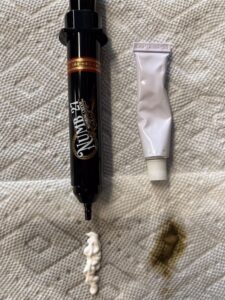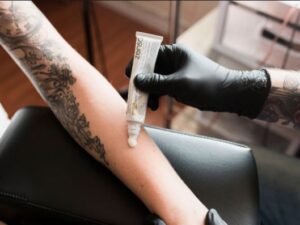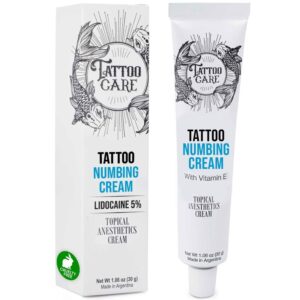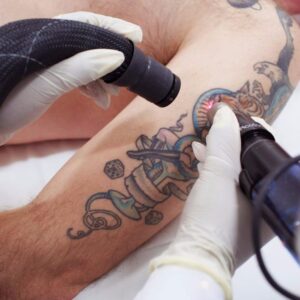The Science Behind Numbing Cream for Tattoos
Understanding how numbing cream works requires a closer look at the science behind it. Numbing creams primarily contain local anesthetics like lidocaine, prilocaine, and benzocaine. These compounds work by blocking sodium channels in the nerve cells of the skin, which are responsible for sending pain signals to the brain. When these channels are blocked, the nerve cells are unable to communicate effectively, leading to a temporary loss of sensation in the area where the cream is applied.
Lidocaine, for example, is one of the most common ingredients in numbing creams. It has been used for decades in various medical and cosmetic procedures, from dental work to minor surgeries. Its efficacy in numbing the skin has made it a go-to ingredient for numbing creams used in tattooing.


The depth and duration of the numbing effect depend on the concentration of the active ingredient and how long the cream is left on the skin. Higher concentrations and longer application times typically result in more profound and lasting numbness. However, there is a balance to be struck, as overly prolonged use or excessive amounts can lead to adverse effects, including potential toxicity.
The Application Process: Ensuring Maximum Effectiveness
For those considering the use of numbing cream for tattoos, getting the application process right is crucial. Here’s a more detailed guide to ensure you achieve the best possible results:
- Prepare the Skin: Begin by cleaning the area thoroughly with soap and water. Removing dirt, oils, and bacteria is essential, as these can hinder the cream’s absorption and increase the risk of infection. After cleaning, pat the area dry with a clean towel.
- Apply the Cream Generously: Use a thick layer of numbing cream over the area where the tattoo will be placed. Ensure that the entire area is covered, but avoid spreading the cream too thin, as this can reduce its effectiveness.


- Wrap the Area: Covering the applied cream with plastic wrap or cling film is a vital step. The plastic wrap helps to trap heat, which aids in the absorption of the active ingredients into the skin. It also prevents the cream from rubbing off on clothes or furniture.
- Wait Patiently: The cream needs time to work, so it’s important to apply it at least 30 minutes to an hour before your tattoo session. Some users opt to leave the cream on for up to two hours for maximum numbing, but this should only be done if it’s safe according to the product’s instructions.
- Remove the Wrap Carefully: Once you’re ready for your tattoo session, remove the plastic wrap and gently wipe away any excess cream. Your skin should now feel numb to the touch. If you still feel significant sensation in the area, you might need to wait a bit longer or apply a second layer, depending on the product instructions.
- Communicate with Your Tattoo Artist: Let your tattoo artist know that you’ve used numbing cream. This information is important, as the artist may need to adjust their technique slightly based on how your skin reacts to the cream.
Common Concerns and Misconceptions #Numbing Cream for Tattoos
Despite the benefits of using numbing cream for tattoos, some concerns and misconceptions still exist. Addressing these can help you make a more informed decision:
-
- “Numbing cream ruins the tattoo process.” #Numbing Cream for Tattoos
Some fear that numbing cream might interfere with the tattoo process, either by affecting the ink or making the skin more difficult to work with. While it’s true that some numbing creams can cause the skin to become firmer or more resistant to tattoo needles, this is usually only a concern with excessive use or incorrect application. Most reputable numbing creams, when used as directed, should not significantly affect the quality of your tattoo.
- “Numbing cream ruins the tattoo process.” #Numbing Cream for Tattoos


- “You can build a tolerance to numbing cream.”
There’s a common belief that repeated use of numbing cream can lead to a tolerance, where the cream becomes less effective over time. However, this isn’t entirely accurate. While your body might respond differently to the cream over time, true tolerance to local anesthetics like lidocaine is rare. If you find that the cream is becoming less effective, it might be due to factors like skin thickness, the specific area being tattooed, or even the duration of the tattoo session. - “Numbing cream is only for those who can’t handle pain.” #Numbing Cream for Tattoos
Another misconception is that using numbing cream is a sign of weakness or an inability to handle pain. In reality, numbing cream is a tool that can make the tattooing experience more comfortable, regardless of your pain tolerance. Many experienced tattoo enthusiasts use numbing cream for lengthy or intricate tattoos where pain might become a distraction or make the process more difficult.
What to Do If Numbing Cream Wears Off During the Session #Numbing Cream for Tattoos
One of the challenges with numbing cream is that its effects are temporary. If you’re getting a large or detailed tattoo, there’s a chance that the cream might wear off before the session is complete. Here’s what you can do if you find yourself in this situation:
- Stay Calm and Communicate: If you notice the numbing effect starting to fade, let your tattoo artist know immediately. They can adjust their technique, take a break, or even apply a different pain relief method if needed.


- Use Mental Techniques: Breathing exercises, meditation, and focusing on your breathing can help manage the pain if the numbing cream starts to wear off. These techniques can help you stay calm and reduce the intensity of the discomfort.
- Take a Break: If the pain becomes too intense, consider taking a short break. This can give your body a chance to adjust, and in some cases, the pain might feel less intense after a brief rest.
- Plan Ahead: If you’re concerned about the numbing cream wearing off, talk to your tattoo artist before the session starts. They might suggest doing the most painful parts of the tattoo first or planning the session in stages, with breaks in between to reapply the cream if necessary.
The Evolution of Pain Management in Tattooing #Numbing Cream for Tattoos
Pain management in tattooing has come a long way over the years. In the early days, tattooing was often seen as a test of endurance, with little consideration given to managing pain. As the practice became more widespread, various methods were developed to help reduce discomfort.
Before the advent of modern numbing creams, tattoo artists and clients relied on techniques like:
- Ice Packs: Applying ice to the skin before a tattoo session was a common practice to numb the area. While somewhat effective, ice packs were far from ideal, as the numbing effect was short-lived and could cause the skin to become stiff, making it harder to tattoo.

- Alcohol: Some people would consume alcohol before a tattoo session to dull the pain. However, this method is not recommended, as alcohol can thin the blood, leading to excessive bleeding and potentially impacting the quality of the tattoo.
- Topical Anesthetics: Early forms of topical anesthetics were used in some tattoo shops, but these were often rudimentary and not specifically designed for tattooing. As the demand for pain management grew, more specialized products were developed, leading to the numbing creams we see today.
Tattoo Culture and the Stigma Around Pain Management #Numbing Cream for Tattoos
In the tattoo community, there has historically been a certain level of pride associated with enduring the pain of getting inked. This “no pain, no gain” mentality is deeply ingrained in the culture, with many viewing the discomfort as part of the process and a rite of passage.
However, as tattoos have become more mainstream, the stigma around pain management has started to fade. More people are embracing the idea that getting a tattoo doesn’t have to be an excruciating experience. Numbing cream for tattoos is becoming increasingly accepted as a practical tool for making the process more accessible and enjoyable for everyone.


The Role of Tattoo Artists in Pain Management #Numbing Cream for Tattoos
Tattoo artists play a crucial role in guiding clients through the pain management process. Experienced artists understand that every client has a different pain threshold and that managing discomfort is essential to creating a positive experience.
Many artists will recommend numbing cream for tattoos to clients who are anxious about the pain or who are getting tattoos in particularly sensitive areas. They can also offer advice on other pain management techniques, such as breathing exercises or scheduling shorter sessions for those who are nervous.
Ultimately, the goal is to ensure that the client feels comfortable and confident during the tattoo process, leading to a better overall experience and a more successful tattoo.
Future Trends in Tattoo Pain Management #Numbing Cream for Tattoos
As technology and medical research continue to advance, the future of tattoo pain management looks promising. Here are some trends that might shape the industry in the coming years:
- Advanced Numbing Formulas: Researchers are continually working on developing more effective numbing agents that provide longer-lasting relief without adverse side effects. We might see new formulas that offer deeper penetration and more prolonged effects, making them ideal for lengthy tattoo sessions.
- Combination Products: Future products might combine numbing agents with other beneficial ingredients, such as anti-inflammatory compounds or skin-soothing elements. These combination products could help reduce pain while also promoting faster healing and reducing post-tattoo swelling and redness.


- Customizable Pain Relief Options: With advancements in personalized medicine, it’s possible that we’ll see customizable pain relief options tailored to individual clients. These could include specific formulations based on skin type, tattoo location, and even the type of ink used.
- Virtual Reality Distraction Techniques: Some tattoo shops are experimenting with virtual reality (VR) as a distraction technique during tattoo sessions. VR can immerse the client in a different environment, helping them focus on something other than the pain. This method could
Numbing Cream and Its Impact on the Tattoo Industry #Numbing Cream for Tattoos
The introduction and widespread acceptance of numbing cream have had a significant impact on the tattoo industry as a whole. Here’s how:
- Expanding the Client Base: Numbing cream has made tattooing accessible to individuals who might otherwise avoid getting inked due to a low pain threshold. This includes people with chronic pain conditions, those with sensitive skin, and individuals who are simply nervous about the discomfort associated with tattoos. By reducing the fear of pain, numbing cream has helped attract a wider range of clients to tattoo shops.
- Longer Tattoo Sessions: For those interested in larger pieces or full-body tattoos, managing pain is crucial. Numbing cream allows clients to sit through longer sessions without needing frequent breaks, which can help the artist maintain momentum and produce a more consistent result. This is particularly beneficial for tattoos that require multiple hours or even multiple sessions to complete.

- Improved Client Comfort: Tattoo artists who recommend or provide numbing cream are often seen as more considerate and client-focused. By prioritizing the client’s comfort, these artists can build stronger relationships with their clients, leading to repeat business and positive word-of-mouth referrals.
- Increased Focus on Aftercare: The use of numbing cream also highlights the importance of proper aftercare. Clients who use numbing cream are often more attentive to aftercare instructions, as they’ve already taken steps to ensure a positive experience during the tattoo process. This can lead to better healing outcomes and a more vibrant final tattoo.
The Ethical Considerations of Using Numbing Cream #Numbing Cream for Tattoos
While numbing cream offers clear benefits, there are ethical considerations that both clients and tattoo artists should keep in mind:
- Informed Consent: Tattoo artists should always inform their clients about the use of numbing cream, including any potential risks or side effects. Clients should be fully aware of what they’re applying to their skin and how it might impact the tattooing process.
- Respecting Client Autonomy: Some clients might feel pressured to use numbing cream, especially if they’re anxious about the pain. It’s important for tattoo artists to respect the client’s autonomy and support their decision, whether they choose to use numbing cream or not.
- Professional Integrity: Artists should only recommend reputable numbing creams that are safe and effective. Using subpar products can lead to poor outcomes and harm the artist’s reputation. It’s essential to stay informed about the latest products on the market and to choose those that have been tested and proven to be safe for use in tattooing.


Alternatives to Numbing Cream for Pain Management #Numbing Cream for Tattoos
While numbing cream is a popular choice, it’s not the only method for managing pain during a tattoo session. Here are a few alternatives:
- Breathing Techniques: Controlled breathing is a simple yet effective way to manage pain. By focusing on deep, steady breaths, clients can reduce anxiety and help their body cope with discomfort.
- Topical Cooling Sprays: Some tattoo shops offer cooling sprays that can be applied during the tattoo session. These sprays provide temporary relief and can be used in conjunction with numbing cream or on their own.
- Pain-Relief Medication: Over-the-counter pain relievers, such as ibuprofen or acetaminophen, can help reduce pain and inflammation during a tattoo session. However, it’s important to consult with both your tattoo artist and a healthcare provider before taking any medication, as some pain relievers can thin the blood and lead to increased bleeding.
- Mindfulness and Meditation: Techniques like mindfulness and meditation can help clients manage pain by focusing their attention away from the discomfort. These practices can be particularly helpful for those who prefer to avoid using creams or medications.
The Future of Numbing Cream in Tattooing #Numbing Cream for Tattoos
As the tattoo industry continues to grow and evolve, the role of numbing cream is likely to become even more significant. Here are a few predictions for the future:
- More Advanced Formulations: As research into pain management progresses, we can expect to see more advanced numbing creams that offer longer-lasting effects with fewer side effects. These formulations could become standard in tattoo shops, particularly for large or intricate tattoos.
- Wider Acceptance: As the stigma around pain management continues to decrease, more clients will feel comfortable using numbing cream, leading to its wider acceptance in the industry. This shift could also encourage tattoo artists to incorporate pain management strategies into their standard practices.
- Integration with Aftercare Products: In the future, we might see numbing creams that are specifically designed to be used as part of a comprehensive aftercare routine. These products could help soothe the skin after the tattoo is complete, promoting faster healing and reducing the risk of complications.
- Educational Resources: As numbing cream becomes more popular, there’s likely to be an increase in educational resources for both clients and tattoo artists. These resources could include guides on proper application techniques, information on different types of numbing creams, and advice on how to incorporate pain management into the tattooing process.

FAQs About Numbing Cream for Tattoos #Numbing Cream for Tattoos
To provide a comprehensive understanding of numbing cream for tattoos, let’s dive into some frequently asked questions:
1. Can I use numbing cream for tattoos on any part of my body? #Numbing Cream for Tattoos
Yes, numbing cream can generally be used on most parts of the body. However, areas with thinner skin or closer to bones, like the hands, feet, or ribs, may require more careful application. Always consult your tattoo artist and follow the product’s instructions to ensure safe use.
2. Is there a difference between numbing creams and numbing gels? #Numbing Cream for Tattoos
Both numbing creams and gels serve the same purpose, but they differ in texture and absorption rates. Numbing creams are thicker and might take longer to absorb, while gels are lighter and may penetrate the skin more quickly. The choice between the two often comes down to personal preference and the specific area being tattooed.
3. Can numbing cream be reapplied during a long tattoo session? #Numbing Cream for Tattoos
It’s generally not recommended to reapply numbing cream during a tattoo session, as this can increase the risk of skin irritation or allergic reactions. If you’re concerned about the numbing effect wearing off, discuss alternative pain management options with your tattoo artist before the session begins.
4. Are there any long-term effects of using numbing cream for tattoos? #Numbing Cream for Tattoos
When used as directed, numbing cream for tattoos does not typically cause long-term effects. However, overuse or improper application can lead to temporary skin irritation or changes in skin texture. It’s important to follow the product instructions and consult with your tattoo artist to avoid any potential issues.
5. How do I choose the right numbing cream for my tattoo? #Numbing Cream for Tattoos
Choosing the right numbing cream depends on several factors, including the size and location of the tattoo, your skin type, and any allergies you might have. It’s a good idea to do some research on different brands, read reviews, and consult with your tattoo artist for recommendations.